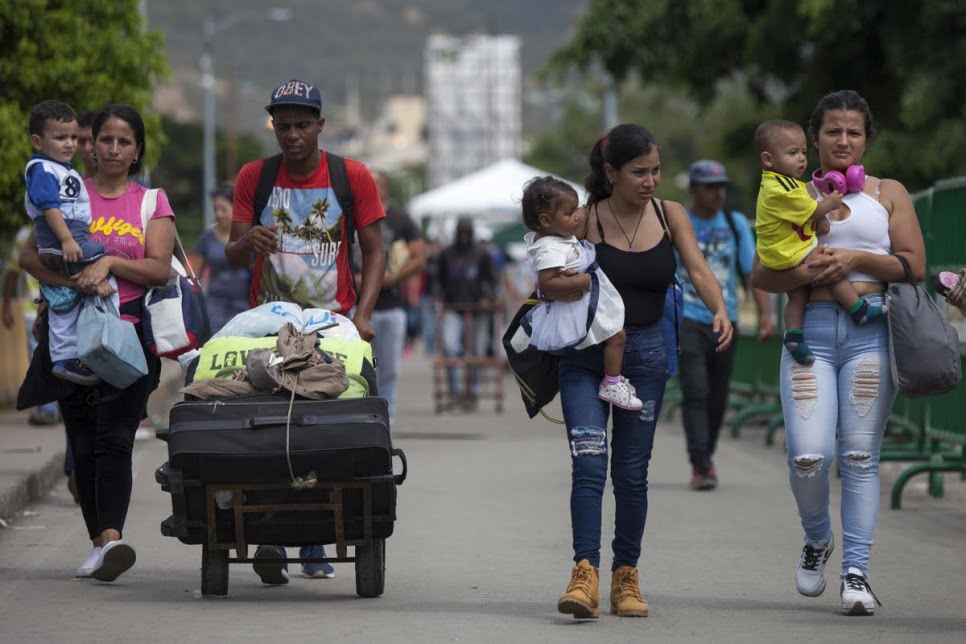The current political upheaval in Venezuela was preceded by Latin America’s worst-ever refugee crisis. By most estimates, several thousand Venezuelans are fleeing the country every day. Most are going to neighboring Colombia. But every country in the region is impacted.
The numbers are massive. Over 3 million people have fled the country over the last few years. This is about 10% of the country’s total population. In recent months, the numbers of people fleeing the country has intensified.
By some estimates, 25,000 people are fleeing the country every single day.
Colombia is accepting the vast number of refugees from Venezuela
Over one million Venezuelans have fled to Colombia. This is a remarkable fact considering that refugee movements used to move the other direction; Colombia’s long civil war unfolded during a time of relative prosperity in Venezuela.
The NGO Action Against Hunger offered this view from the border town of Cúcuta in early Februarry:
The flow of Venezuelans at the northeastern Colombian border city of Cúcuta is constant.
“People come to buy food, medicines, hygiene items and basic goods, or to sell jewelry and other small technological goods – many women are even selling their hair,” says Luis Fernando Ramírez, project coordinator for Action Against Hunger in the department of Norte de Santander.
Although many people return in the day, the permanent arrival of an estimated 90,000 people every month puts a constant pressure on the area. There are currently more than one million Venezuelans in Colombia.
“We are also talking about an area where armed groups continue to operate, so it is a doubly affected area,” Ramirez adds.
“Many people enter the country through the city of Cúcuta in order to reach Rumichaca and then their final destination is Peru,” explains Ramírez.
“Walking this route is 32 days on the road. At first we detected that there were about 20-30 people per day. Now there are around 200 or 300 people daily. The number of children making this route has increased, as well as vulnerable pregnant women, the elderly, and people with disabilities. The migrants also face the risk of trafficking and hunger along the way.”
After Colombia, Peru is a the second most popular destination country for Venezuelan refugees, with over 500,000, according to the UN Refugee Agency. It is followed by Ecuador, with over 220,000, Argentina over 130,000, Chile, over 100,000 and Brazil, 85,000.
Countries in Central America and the Caribbean are also increasingly a destination for fleeing Venezuelans.
Panama is now hosting 94,000 Venezuelans, according to the UN Refugee Agency. Small countries like Trinidad and Tobago are also feeling the burden of hosting Venezuelan refugees. The island country is located just seven miles off the coast of Venezuela. It has a small population–about 1.2 million people. As of the end of January, over 40,000 Venezuelans had fled to the islands of Trinidad and Tobago. This makes it the country with the largest proportion of Venezuelan migrants in the region.
The outmigration from Venezuela happened in stages.
Andrei Serbin Pont is the research director of the regional think tank Cries. He recently undertook a study of the Venezuelan refugee crisis with the Stanley Foundation. As he explains in this episode of the Global Dispatches podcast, the first Venezuelans to flee the country at the outset of this crisis were mostly upper and middle class people who could more easily afford they journey. Many in this first cohort ended up in the United States.
But as the crisis dragged on and the situation became more and more desperate, the demographics of these refugees shifted. More and more poor people began to flee–and these people were particularly vulnerable. The regional response has been uneven, with some countries offering more protections to these refugees than others.
Get Global Dispatches Podcast
iTunes | Spotify | Stitcher | Google Play Music
We spoke last year as the refugee crisis was intensifying–and since then the situation has only gotten worse. While the politics of this situation are evolving, this conversation offers the context you need to understand the humanitarian and refugee dimension of this crisis.
